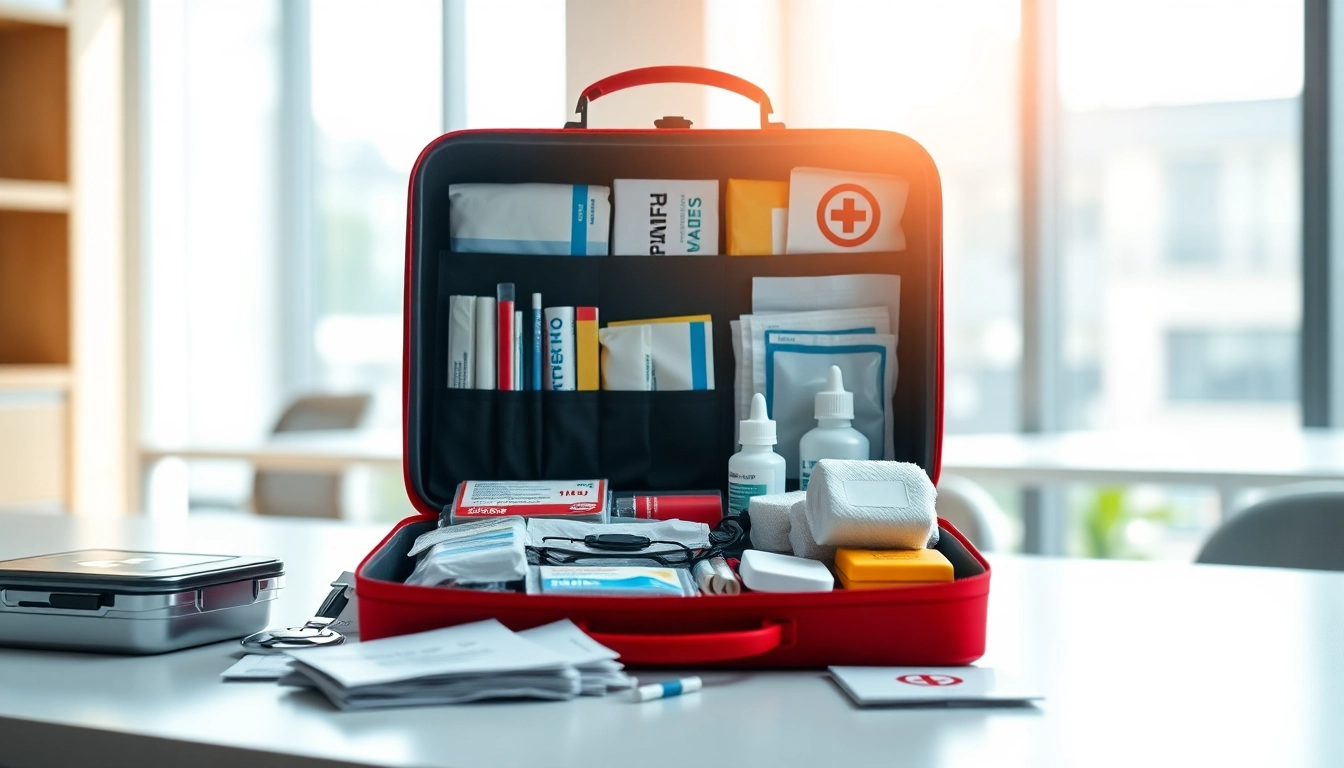Understanding the Importance of Workplace First Aid Kit in Kenya
In any workplace, safety and preparedness are paramount. One essential element of workplace safety is having a well-stocked workplace first aid kit in Kenya. This kit is not just a box of supplies; it is a critical resource that can mean the difference between life and death in emergency situations. Understanding the significance of these kits is vital for any organization aiming to provide a safe working environment.
Legal Requirements for First Aid Kits
In Kenya, occupational safety regulations emphasize the importance of first aid preparedness in the workplace. According to the Occupational Safety and Health Act, every employer is required to ensure that appropriate first aid measures are available for their employees. This includes providing adequate first aid kits that meet the specifications set by health authorities. Specifically, these kits should be proportional to the number of employees and the nature of the workplace, ensuring that everyone has access to necessary medical care in case of an emergency.
Health Benefits of Being Prepared
Being prepared with a workplace first aid kit not only complies with legal standards; it also offers numerous health benefits. When a workplace has a first aid kit readily available, minor injuries can be treated immediately, preventing complications and promoting faster recovery. This preparedness can greatly reduce absenteeism due to avoidable injuries. Furthermore, demonstrating that an employer is proactive about safety fosters a culture of care and responsibility, potentially enhancing employee morale and trust in the organization.
Types of Emergencies Addressed by First Aid Kits
A comprehensive workplace first aid kit should be equipped to handle various emergencies including, but not limited to:
- Cuts and abrasions
- Burns
- Sprains and strains
- Fractures
- Cardiac arrests
- Choking incidents
- Anaphylactic shocks
Each type of injury requires specific supplies and knowledge to address effectively, making a well-assembled kit indispensable for workplace safety.
Components of a Comprehensive Workplace First Aid Kit in Kenya
Key Items Every Kit Should Include
A comprehensive workplace first aid kit should contain basic medical supplies that cater to a variety of potential injuries. Essential items that should be included are:
- Adhesive bandages of various sizes
- Sterile gauze pads and adhesive tape
- Antiseptic wipes or solutions
- Disposable gloves
- Scissors and tweezers
- Pain relievers (like acetaminophen or ibuprofen)
- An emergency blanket
- A CPR face shield
Including these items ensures that the first responders on-site have the necessary tools to effectively manage injuries until professional medical help arrives.
Additional Supplies for Specific Industries
Different industries may face unique risks that require tailored first aid supplies. For instance:
- In manufacturing settings, supplies such as cold packs and splints may be vital due to the increased risk of sprains and fractures.
- In construction, additional safety items like a tourniquet for severe bleeding and fall protection gear might be required.
- Offices may benefit from a larger stock of antiseptics and bandages, considering the potential for cuts from paper or minor accidents.
Conducting a risk assessment of the workplace can guide employers in customizing their first aid kits to adequately meet their specific needs.
Assessing Your Workplace’s Needs
To create an effective first aid strategy, it is crucial to assess various factors, including:
- The size of the workforce
- The layout of the workplace
- The specific hazards associated with the work being done
- Employee demographics and health concerns
Regularly reviewing and updating this assessment will ensure that the workplace first aid kit remains relevant and effective in addressing the safety needs of all employees.
Buying the Right Workplace First Aid Kit in Kenya
What to Look for When Purchasing
When selecting a workplace first aid kit, there are several factors to consider to ensure it meets the needs of your organization. Key considerations include:
- Compliance with local regulations: Make sure the kit meets the local health authority guidelines for occupational first aid kits.
- Size and capacity: The kit should be large enough to accommodate the number of employees and the types of injuries typically encountered in the workplace.
- Durability: Kits should be stored in sturdy, waterproof containers that protect the supplies from environmental factors.
Additionally, it’s beneficial to consider whether the kit can be customized to include specific items that may be essential for your workplace.
Evaluating Quality and Compliance
Quality should never be compromised when purchasing a workplace first aid kit. Check for:
- Expiration dates on supplies to ensure they are within usable limits
- Durability of the container and items within
- Reputable manufacturers and suppliers, ensuring that the kit adheres to compliance standards
Making sure that your first aid kit is high-quality reduces the risk of malfunction or failure when it is needed most.
Where to Buy Certifiable Kits
Purchasing your workplace first aid kit from certified suppliers guarantees that you receive a product meeting required standards. Several online platforms, safety supply stores, and local health outlets provide various first aid kits suitable for workplaces. Always verify that the supplier adheres to the standards laid out by health authorities to ensure compliance and quality.
Maintaining and Replenishing Your Workplace First Aid Kit in Kenya
How to Check Expiry Dates and Stock Levels
Accessing first aid supplies is crucial during emergencies, making regular checks on stock levels imperative. A simple maintenance routine should include:
- Monthly inspections to ensure all items are present and usable
- Checking expiration dates on medications, antiseptics, and sterile supplies
- Replenishing any used items immediately after each incident or on a scheduled basis
Documenting these checks can help in maintaining accountability and ensuring the kit is always ready for use.
Steps for Regular Maintenance
Implementing a structured maintenance program for workplace first aid kits can enhance their effectiveness. Recommended steps include:
- Designate a responsible person or team for monitoring first aid supplies.
- Create a checklist of essential items and their expiry dates.
- Schedule regular audits on a quarterly basis to ensure compliance and adequacy.
- Provide training on how to maintain the kit using the checklist and procedures.
By having a clear maintenance protocol, organizations ensure their first aid resources are not only complete but also reliable during emergencies.
Guidelines for Refilling Supplies
Refilling supplies in a workplace first aid kit is critical to its ongoing effectiveness. Guidelines for efficient refilling include:
- Develop a plan for restocking items based on usage patterns observed in your organization.
- Establish relationships with reliable suppliers to ensure timely purchasing and delivery of replenished supplies.
- Keep records of what items are frequently used to help in future purchasing decisions.
Ensuring supplies are refilled promptly not only prepares workplaces for potential emergencies but also fosters a culture of safety among employees.
Training for Effective First Aid Response in the Workplace
Importance of First Aid Training
Having a well-stocked workplace first aid kit is just the start; understanding how to use the items within it is equally important. First aid training enhances employee confidence and effectiveness in emergency response situations. Employees equipped with first aid knowledge can stabilize injured parties, reducing the severity of injuries and potentially saving lives.
Recommended Training Programs
Many organizations offer first aid training tailored for workplace environments. Recommended programs typically include:
- CPR and AED training
- Basic wound care and management
- First responder courses
- Emergency preparedness workshops
Choosing programs that are certified and recognized by health authorities ensures the training adheres to professional standards and provides practical, applicable skills in real-world situations.
Creating a First Aid Response Team
A First Aid Response Team can be an invaluable resource in any workplace. Building such a team involves:
- Selecting trained individuals from various departments to ensure coverage throughout the workplace.
- Providing ongoing training and refresher courses to keep skills updated.
- Designating roles within the team, such as lead responder, supply manager, and communication liaison during emergencies.
The establishment of a dedicated team not only improves emergency response efficiency but also demonstrates the organization’s commitment to employee health and safety.
Conclusion
In conclusion, having a well-equipped and maintained workplace first aid kit in Kenya is crucial for safeguarding the health and safety of employees. From understanding the legal requirements and health benefits to ensuring proper maintenance and training, there are multiple factors that contribute to effective workplace first aid preparedness. By prioritizing these elements, organizations position themselves to manage emergencies effectively, safeguarding their most valuable asset—their people.















Leave a Reply